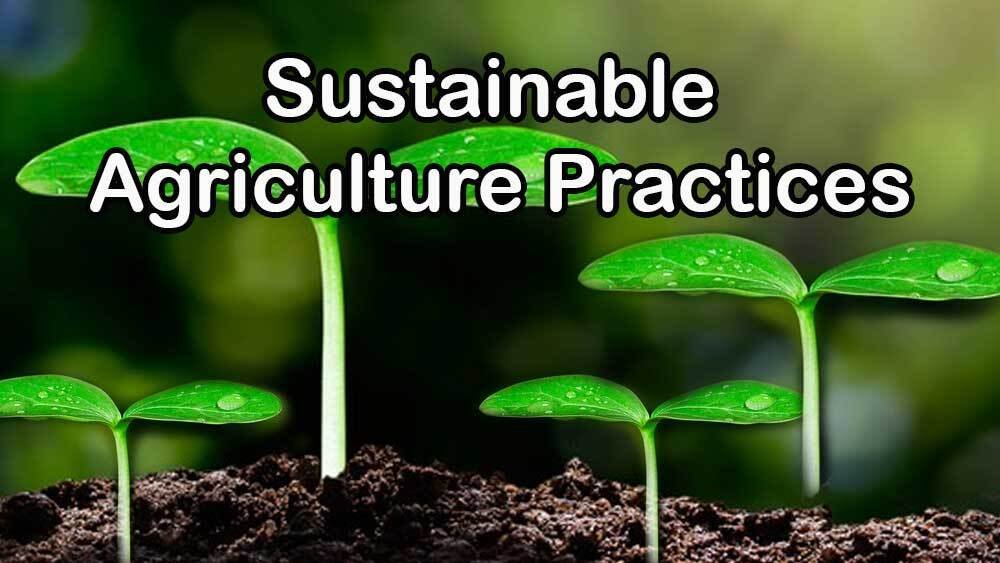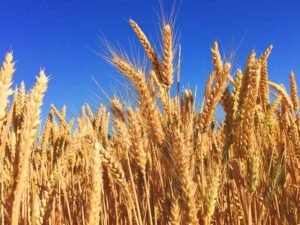Sustainable farming involves practices that aim to minimize environmental impact, promote biodiversity, and ensure long-term agricultural productivity. Sustainable farming, also known as Sustainable Agriculture, is an approach to agriculture that aims to meet the needs of the present without compromising the ability of future generations to meet their own needs. It involves the use of practices and systems that promote environmental stewardship, economic viability, and social responsibility.
Here are ten methods for Sustainable farming:
1. Integrated Pest Management (IPM): Integrated Pest Management (IPM) is a Sustainable approach to managing pests in agriculture that combines biological, cultural, physical, and chemical tools in a way that minimizes economic, health, and environmental risks. The goal of IPM is to manage pests efficiently while reducing the use of chemical pesticides and their impact on the environment. precision Agriculture
IPM is a dynamic and holistic approach that considers the entire agroecosystem. By integrating multiple pest management strategies, IPM helps reduce the reliance on chemical pesticides, minimizes the development of pesticide resistance, and promotes Sustainable and environmentally friendly agricultural practices.
Read more: High Yield Pumpkin farming Guide

Employ a holistic approach to pest control, combining biological, cultural, and mechanical methods to minimize the use of chemical pesticides. This approach helps maintain a balance between pests and beneficial organisms. Precision Farming:
2. Organic Farming: Organic agriculture is a farming system that avoids the use of synthetic pesticides, herbicides, fertilizers, and genetically modified organisms (GMOs), focusing instead on environmentally friendly and Sustainable practices.
The primary goal of organic Farming is to produce food in a way that is ecologically balanced, promotes soil health, and minimizes the environmental impact of agricultural activities. Avoid synthetic pesticides and fertilizers, relying instead on organic inputs, compost, and natural pest control methods. This helps maintain soil health and reduces chemical runoff.

Read more: Benefits of Grafted Vegetable Farming
3. Crop rotation: Crop rotation is a fundamental practice in organic agriculture with several key benefits that contribute to the overall health and sustainability of the farming system.
Different crops have different nutrient needs. Crop rotation helps prevent the depletion of specific nutrients from the soil, as each crop takes up and releases different nutrients. This helps maintain soil fertility over time without relying heavily on synthetic fertilizers. It disrupts the life cycles of pests and pathogens, reducing the build-up of populations that can lead to outbreaks. This helps control diseases and pests without the excessive use of synthetic pesticides, a key principle in organic Farming.
Certain diseases are specific to particular plant families. By rotating crops, farmers can break the cycle of diseases that affect a specific plant group. This natural break can help prevent the recurrence of diseases without resorting to chemical treatments.

Read more: High Yield Wheat Planting Care & Harvesting Guide
Crop rotation can improve water use efficiency by optimizing the timing and depth of root growth. This is particularly important in regions where water availability is a limiting factor for crop production.
4. Improved Soil Structure: Yes, improved soil structure is a crucial component of Sustainable soil management. Soil structure refers to the arrangement and organization of soil particles into aggregates, which can greatly influence the soil’s ability to support plant growth, water movement, and nutrient cycling. Sustainable soil management aims to maintain or enhance soil health over the long term, and achieving and maintaining good soil structure is integral to this goal. Here’s why:
Well-structured soil allows water to infiltrate more easily, reducing runoff and erosion. At the same time, it helps the soil retain moisture for longer periods, which is especially important in areas with erratic rainfall or during dry periods.

Read more: Tissue Culture Guava Plantaion Guide
Good soil structure provides an optimal environment for root growth. It allows roots to penetrate the soil easily, accessing nutrients and water. Well-structured soil also promotes good aeration, ensuring an adequate supply of oxygen to plant roots.
Soil structure influences the availability of nutrients to plants. Properly structured soil allows for better nutrient retention and exchange between soil particles and plant roots. This is essential for supporting healthy plant growth.
5. Agroforestry: Yes, agroforestry is indeed a part of Sustainable farming. Agroforestry is a land-use management system that integrates trees and shrubs with crops and/or livestock in a way that creates environmental, economic, and social benefits. It combines elements of agriculture and forestry to create a more diverse, productive, and Sustainable land-use system.
Agroforestry systems promote biodiversity by incorporating a variety of plant species. The presence of trees alongside crops and livestock provides habitat for a diverse range of organisms, contributing to overall ecosystem health.

Read more: How To Do Profitable Farming?
Trees in agroforestry systems can help improve soil fertility and structure. They can contribute organic matter to the soil through leaf litter and root systems, prevent soil erosion, and enhance water retention.
Agroforestry can enhance the resilience of agricultural systems to climate change. The presence of trees can provide shade, reducing temperature extremes, and contribute to microclimate regulation. Additionally, certain tree species may be more resilient to specific climate conditions.
6. Cover Cropping: Cover cropping is a key component of Sustainable Agriculture. Cover cropping involves growing plants, known as cover crops or green manure, primarily for the purpose of improving soil health and fertility, managing pests, preventing erosion, and enhancing overall sustainability in agricultural systems.
Covers crops help improve soil structure by preventing soil erosion and compaction. Their root systems enhance soil aeration and drainage. As cover crops decompose, they contribute organic matter to the soil, promoting microbial activity and nutrient cycling.
Cover crops can be strategically selected to capture and recycle nutrients, preventing leaching and making them available for subsequent crops. Leguminous cover crops, for example, have the ability to fix nitrogen from the atmosphere, enriching the soil with this essential nutrient.
Cover crops can suppress weed growth by competing for sunlight, nutrients, and space. This can reduce the need for synthetic herbicides and promote a more Sustainable and ecologically friendly weed management approach.
Some cover crops release compounds that deter pests or attract beneficial insects, acting as a form of natural pest control. This can contribute to reducing the reliance on chemical pesticides.Plant cover crops during the off-season to protect the soil from erosion, suppress weeds, and add organic matter. Cover crops can also fix nitrogen, reducing the need for synthetic fertilizers.
Read more: Soil Fertility & Crop Selection
7. Conservation Tillage: Conservation tillage is considered a key practice in Sustainable farming. Conservation tillage refers to any method of soil cultivation that reduces the frequency and intensity of tillage while retaining crop residues on the soil surface. The aim is to minimize soil disturbance and erosion, improve soil structure, and enhance overall sustainability in agriculture.
By leaving crop residues on the soil surface, conservation tillage helps to protect the soil from erosion caused by wind and water. This is particularly important in areas with sloping terrain or where heavy rainfall is common.
Reduced tillage helps maintain soil structure and stability. It prevents the breakdown of soil aggregates and preserves the natural pore spaces in the soil, promoting better water infiltration, root penetration, and nutrient distribution.

Read more: How To Do Intercropping In Organic Agriculture?
Conservation tillage practices help improve water retention in the soil. By leaving crop residues on the surface, water runoff is reduced, and moisture is conserved. This is beneficial, especially in regions facing water scarcity.
Leaving crop residues on the soil surface contributes to increased soil organic matter, which in turn enhances carbon sequestration. This is important for mitigating climate change by storing carbon in the soil. Minimize soil disturbance through reduced tillage or no-till methods. This practice helps retain soil moisture, reduce erosion, and preserve soil structure.
8. Water Conservation: Water conservation plays a critical role in Sustainable farming by promoting efficient water use, maintaining soil health, and mitigating the environmental impact of agriculture. Efficient water use helps farmers make the most of limited water resources. By adopting water-saving technologies and practices, farmers can optimize irrigation and reduce water wastage.

Read more: Cashew Farming Information Guide
Sustainable farming aims to minimize the environmental impact of agricultural activities. Efficient water use contributes to this goal by reducing the risk of water pollution through runoff, which can carry sediment, nutrients, and pesticides into nearby water bodies.
Proper water management contributes to healthy soil structure. Excessive irrigation or waterlogging can lead to soil compaction, reduced aeration, and nutrient leaching. Water conservation practices, such as precision irrigation, help maintain optimal soil moisture levels for plant growth and microbial activity.
9. Polyculture: Polyculture is a farming practice that involves cultivating multiple crops or species in the same space, often simultaneously or in a rotating sequence. This contrasts with monoculture, where a single crop is grown on a large scale. Polyculture is a key component of Sustainable Agriculture, providing various ecological, economic, and social benefits.
Polyculture promotes biodiversity by cultivating a variety of crops. This diversity attracts a range of beneficial insects, birds, and microorganisms, creating a more balanced and resilient ecosystem.
Growing different crops together can disrupt the life cycles of pests and diseases. This natural form of pest control helps reduce the need for chemical pesticides, contributing to environmentally friendly and Sustainable farming.
10. Animal Welfare: Animal welfare is a crucial component of Sustainable Agriculture, contributing to the overall health and resilience of farming systems. Ensuring the well-being of farm animals aligns with Sustainable practices by promoting environmental stewardship, social responsibility, and economic viability.
Sustainable Agriculture often involves avoiding the routine use of hormones and antibiotics in livestock. This practice helps prevent the development of antibiotic-resistant bacteria and reduces the environmental impact associated with pharmaceutical runoff.

Read more: Difference between Organic & Sustainable Agriculture
The promotion of animal welfare in agriculture is an integral part of Sustainable farming practices. It encompasses ethical considerations, environmental stewardship, and economic viability, all of which contribute to building resilient and Sustainable agricultural systems.
Thus, Sustainable agriculture aims to balance the needs of the present without compromising the ability of future generations to meet their own needs, creating a more resilient and environmentally friendly food production system.




